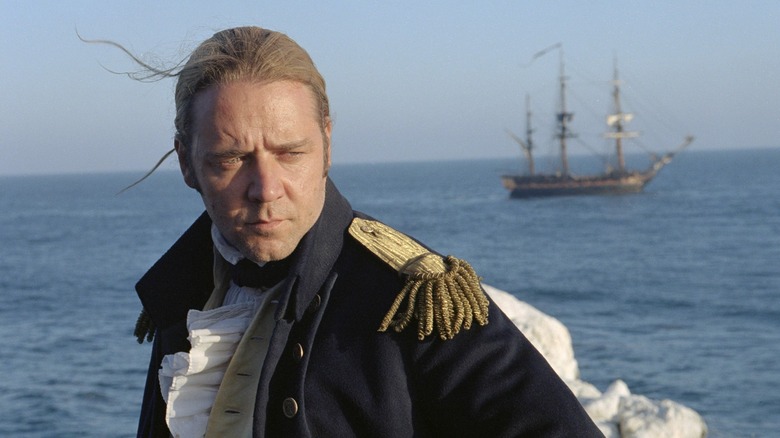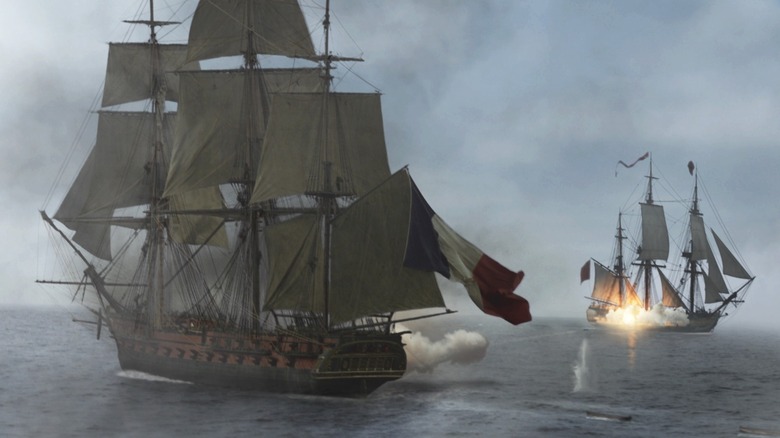Every Frame Of Master And Commander Really Was A Painting
Let's cast our minds back to the distant, fleeting, and downright quaint days of ... the early 2000s. Okay, 20 years isn't that long ago in the grand scheme of things (really, it's not!), but consider quite a few differences between now and then. At the time, the term "shared universe" simply wasn't a thing. The list of highest-grossing movies at the end of each year tended to include original productions like "Gladiator," "Cast Away," "Ocean's 11," and "Signs" instead of just IP-driven fare. And movies as adult-minded, genuinely epic, and incredibly well-made as Peter Weir's "Master and Commander: The Far Side of the World" stood apart because of the strength of its craft ... not merely for existing in the first place.
If I seem a little nostalgic for the good ol' days, well, it's probably because I am. But for all my doom and gloom, "Master and Commander" still stands the test of time, thanks to precisely those qualities I just finished waxing poetic about earlier. The seafaring adventure of a British commander leading a warship during the Napoleonic Wars against France defies all assumptions newcomers may feel inclined to make about it, taking the foundation laid down in author Patrick O'Brian's series of novels and adapting them into an episodic, almost anthological series of constant trials and tribulations on the high seas. Sudden storms, uncooperative winds (mixed with some bad luck in the form of an unfortunate "Jonah," perhaps), and that ever-clever ghost of an enemy ship, the French privateer called the Acheron, form the bulk of the obstacles that the crew of the HMS Surprise must overcome.
But as much as fans of the movie may immediately think of Russell Crowe's Captain Jack Aubrey and Paul Bettany's ship's doctor Stephen Maturin, perhaps one of the greatest aspects of the war epic remains the way that Weir brought those epic battle scenes and sweeping oceanic shots to life. How? By literally turning frames into actual paintings, of course!
Painting the battlefield
No movie production could ever be described as "easy," but the challenges and complexities involved in taking "Master and Commander" from the script to the screen would likely put many other modern films — even $200+ million superhero movies — to shame. Having been nominated at the Academy Awards for Best Art Direction, Best Cinematography (which it won), Best Costume Design, and Best Visual Effects, it sure seems as if all that hard work paid off. That hard work, however, involved an assortment of tricks to bring the film to vivid detail. As director Peter Weir himself explained in a profile with Cinephilia & Beyond:
"Paintings were terribly important in all of these action sequences in terms of getting the volume of smoke, the attitude of ships in close combat and particularly for damage to the vessels... miniatures firing at each other were further enhanced. The sky and the water were all added. We had white smoke in the shot, which was then digitally enhanced to make it black. Until the ship emerges from the smoke, the audience clearly thinks that the English ship has failed in its objective. This created more tension.
The slightly larger miniature mast and the miniature ships were composited by ILM. But the key thing I had to always remind them of was that it shouldn't look too smooth. You can do so much with CGI that sometimes it can look too perfect. I wanted them to imagine they were doing the shot in a camera boat that was rocking so the shot looked a little off."
As much as the film's reputation thrives on its adherence to filming on actual ships and sets, quite a bit of visual trickery was involved to bring out the story's true sense of scope and scale. So when it came to the question of using actual paintings in order to augment the use of miniatures, practical sets, and visual effects rather than opting for the "too perfect" tendency of CGI at the time, you could perhaps say that the creative team behind "Master and Commander" chose the lesser of two ... weevils.

